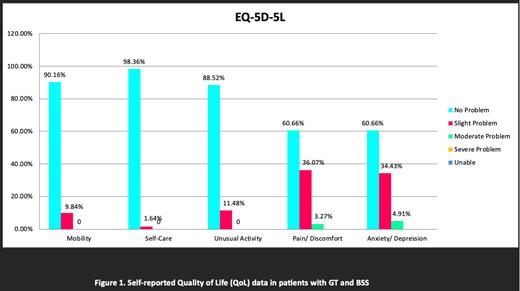Background: Inherited platelet function disorders (IPFDs) are less well studied in a resource poor country in comparison to hemophilia and other bleeding disorders.With high rates of consanguinous marriages in some of the communities in India, Glanzmanns thrombasthenia (GT) and Bernard soulier syndrome (BSS) are the two platelet function disorders that are commonly diagnosed. There is no data on the nature of bleeding, mode of treatment, mortality as well as quality of life (QoL) in these conditions.
Aim : To understand clinical manifestations, treatment, quality-of-life (QoL), mortality and other details in GT and BSS patients.
Methods : This is a retrospective, non-interventional, observational single center data collection study.Subjects were eligible to participate, if they had confirmed reports of laboratory diagnosis of GT or BSS by both platelet aggregometry and flow cytometry studies. Data collected were demographics, medical history, co-morbidities (HIV, HCV, HBV), detailed treatment/product(s) usage, bleeding events, surgical procedures, and other adverse events. It also included patient-reported outcome questionnaires regarding health-related quality of life (HRQoL) using SF-36 and EQ-5D instruments. All data were entered into electronic case report forms by the laboratory personnel.
Results : Sixty one ( GT 50, BSS 11) patients participated in the present study; 31 were males and 30 females. 43 were pediatric patients and 18 adults. Seventeen patients were diagnosed at birth and 10 patients were diagnosed beyond the age of 10 years. Forty four patients (72%) had parental consanguinity. Thirteen patients ( BSS 8, GT 5) did not have any major bleeding manifestations which required treatment. In the remaining patients, the median ABR was 10 ( range 2.5 - >75). The median ISTH BAT score was 10 (range 1-26.)The bleeding manifestations included epistaxis (61%), ecchymosis (58%) , gum bleed (48%), gastrointestinal bleed (28%), soft tissue bleed (23%), hematuria (8%), joint bleed (3%) and intracranial bleed ( 3%). Heavy menstrual bleed (HMB) was the primary bleeding manifestation in all females in the reproductive age group. Four patients were diagnosed following circumcision. Treatment strategies for bleeding events included antifibrinolytic agents alone (26%), platelet transfusion (43%), or whole blood and fresh frozen plasma (39%). Antifibrinolytic agents were also used as adjunct agents with platelet transfusion in majority of the patients. None of the patients were on recombinant activated FVIIa. Overall 8 deaths were reported due to bleeding in these 61 families during the last 10 years, the cause of death mainly being non-availability of treatment products. The self- reported median EQ-5D health score was 82.5 ( range 40-100)
Figure 1 shows the detailed EQ-5D analysis in these 61 patients
Conclusion : Present study provides detailed information of GT and BSS and its impact throughout life. A wide variation in clinical manifestations and disease outcomes was observed, the major attributing factor may possibly be socioeconomic factor which includes access to clinical resources and treatment products for bleed management. Unlike hemophilia, GT and BSS patients do not have the privilege of prophylactic treatment in our country, but there is a need for optimal disease management to normalize both physical and psychosocial outcomes. More such studies will add to an increased understanding of critical issues in these
Disclosures
No relevant conflicts of interest to declare.


This feature is available to Subscribers Only
Sign In or Create an Account Close Modal